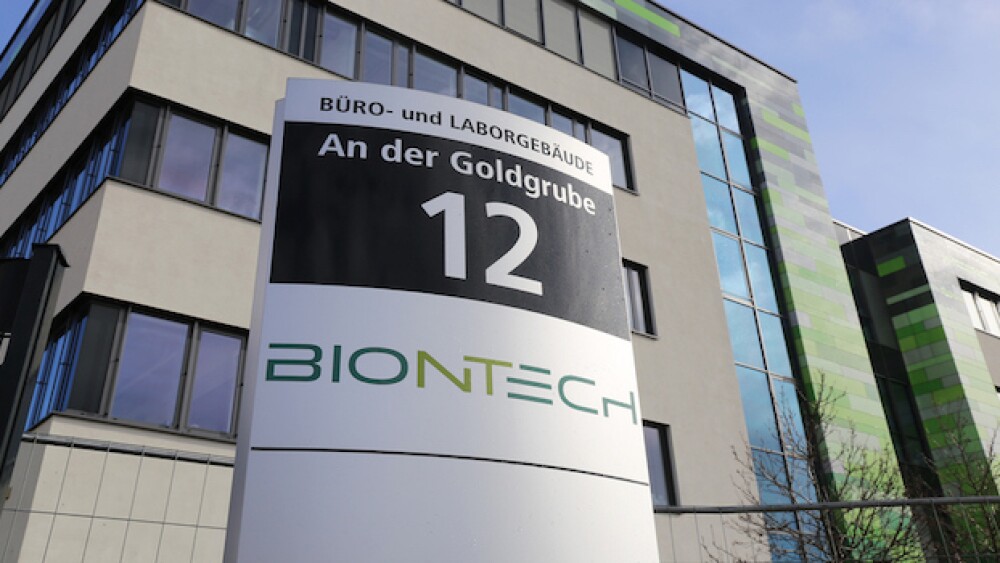A new approach to influenza testing – that uses sugar labelled with gold to distinguish between human and avian strains – has just been patented by researchers on Norwich Research Park. If the flu virus is detected, the rich red of the gold solution will change colour, creating a quick and simple technique that has the potential for use worldwide with minimal training.
The team is a collaboration led by Professor Rob Field of the John Innes Centre and Professor David Russell of University of East Anglia. Prof Russell has already founded a spinout company – Intelligent Fingerprinting that detects drugs and drug metabolites in fingerprints – to exploit his previous work on optically based molecular recognition systems.
Professor Field explains that 90% of infections use carbohydrate recognition to bind with their targets in the human body and this process can be used as a basis for sensor development. He says the same basic principles can be applied wherever rapid detection is required from detecting superbugs in hospitals to biohazards such as ricin.
“We have already developed a carbohydrate-based sensor to detect cholera in contaminated water supplies. The sensor is a suspension of sugars tagged with inexpensive gold nanoparticles. If cholera is present it will attach to the sugar pulling the particles closer together. This creates a change in the photophysics of the suspension, resulting in a colour change that is visible to the naked eye.
“We are now applying these principles to influenza. We have found that different types of flu virus have different sugar binding capabilities, so it is therefore possible to use a colour change not only to identify the presence and absence of the virus but also to distinguish between them.”
On the surface of the human cell are sugar chains containing a molecule called sialic acid. Researchers have found that human flu and avian flu both have receptors for sialic acid but with a preference for different sugar chains. This can be used to differentiate between the flu virus strains.
Professor Russell explained that the new assay based on gold nanoparticles is much faster than current methods of detection.
“Preventing a new influenza pandemic requires both vaccination and antiviral drugs administered within 48 hours of the infection. Current methods of detection require isolation and culture of the virus and may take several hours or even days to get the results; which can be too long for the patient. It is clear that a rapid, diagnostic test that is able to discriminate between the different strains of virus is essential.”
Results recently published in Organic & Biomolecular Chemistry* showed that functionalized gold nanoparticles were able to detect the human influenza virus X31 (H3N2) within 30 minutes and it was able to distinguish between human and avian influenza, which is exceptionally important. This provides proof of concept for this innovative bioassay, which has potential for the specific recognition and detection of influenza virus strains in clinical samples.
Professor Field says the low-tech approach makes it a quick and easy dipstick test that can be used in the field with little training.
After successfully patenting the technique the researchers are now looking for a diagnostics company to partner with to bring it to market.
* Paper reference: Org. Biomol. Chem., 2013,11, 7101-7107 DOI: 10.1039/C3OB41703D
r> Contacts
Victoria Ellis/ Rachel Holdsworth, PR consultants, Holdsworth Associates, Tel: 01954 202789, email: Victoria@holdsworth-associates.co.uk, www.holdsworth-associates.co.uk
Norwich Research Park: Dr Jane Heavens, Projects & Communications Manager, Tel: 01603 274442, email: jane.heavens@norwichresearchpark.com
University of East Anglia Media Relations: Tel: +44 (0) 1603 593496, email: press@uea.ac.uk
JIC press office: 01603 450962, 07768 164185, zoe.dunford@jic.ac.uk
About Norwich Research Park www.norwichresearchpark.com
The Norwich Research Park is a partnership between University of East Anglia, the Norfolk and Norwich University Hospital, four independent world-renowned research institutes namely the John Innes Centre, Institute of Food Research and The Genome Analysis Centre (all strategically funded by the Biotechnology and Biological Sciences Research Council (BBSRC)) and The Sainsbury Laboratory linked to the Gatsby Charitable Foundation. The BBSRC is itself a partner as is the John Innes Foundation.
The vision of the Norwich Research Park partners and local government stakeholders is to develop a thriving science and innovation business park over the next decade by supporting spin-out and start up companies and through attracting inward investment from large corporate organisations involved in science and technology. The Norwich Research Park is home to around 30 science and IT based businesses.
With over 11,000 people including 2,700 scientists, Norwich Research Park is Europe’s leading centre for research in food, health and the environment.
In 2011, the Government awarded BBSRC £26M to invest in Norwich Research Park to deliver innovation from the research base and generate economic growth and job creation. The investment will help to create and support new companies and jobs based on world-leading bioscience.
About the University of East Anglia
The University of East Anglia (UEA) is ranked in the top one per cent of universities in the world and is consistently in the top ten for student satisfaction. It is a leading member of the Norwich Research Park, one of Europe’s biggest concentrations of researchers in the fields of environment, health and plant science. www.uea.ac.uk.
UEA’s School of Chemistry is a leading research centre in the UK, recognised nationally and internationally. 100 per cent of the school’s research was classified as world-leading, internationally excellent or recognised in the most recent Research Assessment Exercise.
www.uea.ac.uk/che
About the John Innes Centre
The John Innes Centre is an independent, international centre of excellence in plant science and microbiology.
Our mission is to generate knowledge of plants and microbes through innovative research, to train scientists for the future, to apply our knowledge to benefit agriculture, the environment, human health and well-being, and engage with policy makers and the public.
www.jic.ac.uk
Tel: 01954 202789
Email: Rachel@holdsworth-associates.co.uk
Web: www.holdsworth-associates.co.uk
Blog: http://blog.holdsworth-associates.co.uk
Twitter: @holdsworthPR
Help employers find you! Check out all the jobs and post your resume.




